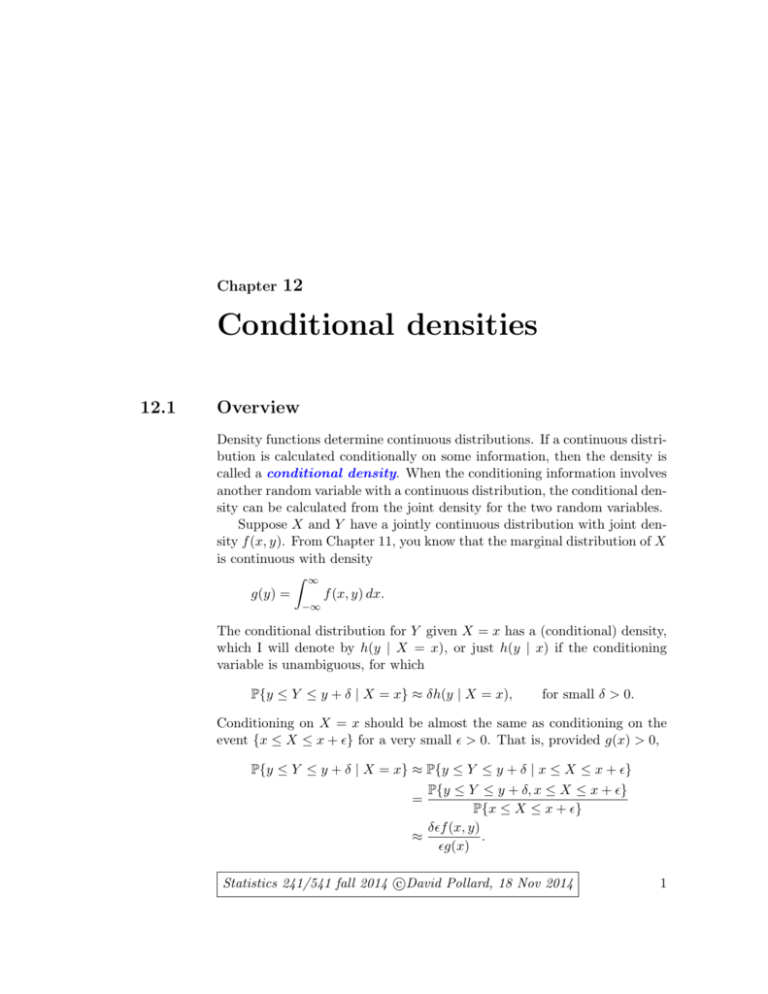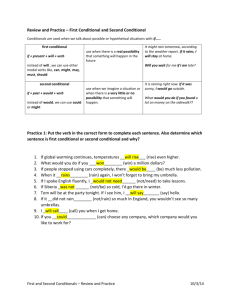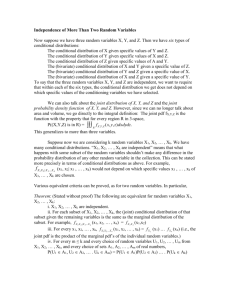Conditional densities
advertisement

Chapter 12
Conditional densities
12.1
Overview
Density functions determine continuous distributions. If a continuous distribution is calculated conditionally on some information, then the density is
called a conditional density. When the conditioning information involves
another random variable with a continuous distribution, the conditional density can be calculated from the joint density for the two random variables.
Suppose X and Y have a jointly continuous distribution with joint density f (x, y). From Chapter 11, you know that the marginal distribution of X
is continuous with density
Z ∞
g(y) =
f (x, y) dx.
−∞
The conditional distribution for Y given X = x has a (conditional) density,
which I will denote by h(y | X = x), or just h(y | x) if the conditioning
variable is unambiguous, for which
P{y ≤ Y ≤ y + δ | X = x} ≈ δh(y | X = x),
for small δ > 0.
Conditioning on X = x should be almost the same as conditioning on the
event {x ≤ X ≤ x + } for a very small > 0. That is, provided g(x) > 0,
P{y ≤ Y ≤ y + δ | X = x} ≈ P{y ≤ Y ≤ y + δ | x ≤ X ≤ x + }
P{y ≤ Y ≤ y + δ, x ≤ X ≤ x + }
=
P{x ≤ X ≤ x + }
δf (x, y)
≈
.
g(x)
c
Statistics 241/541 fall 2014 David
Pollard, 18 Nov 2014
1
12. Conditional densities
2
In the limit, as tends to zero, we are left with δ ≈ δf (x, y)/g(x). That is,
h(y | X = x) = f (x, y)/g(x)
for each x with g(x) > 0.
Less formally, the conditional density is
h(y | X = x) =
joint (X, Y ) density at (x, y)
marginal X density at x
The first Example illustrates two ways to find a conditional density: first
by calculation of a joint density followed by an appeal to the formula for the
conditional density; and then by a sneakier method where all the random
variables are built directly using polar coordinates.
Example <12.1>
Let X and √
Y be independent random variables, each
distributed N (0, 1). Define R = X 2 + Y 2 . Show that, for each r > 0, the
conditional distribution of X given R = r has density
1{|x| < r}
h(x | R = r) = √
π r 2 − x2
for r > 0.
The most famous example of a continuous condition distribution comes
from pairs of random variables that have a bivariate normal distribution.
For each constant ρ ∈ (−1, +1), the standard bivariate normal with
correlation ρ is defined as the joint distribution of a pair of random variables constructed from independentprandom variables X and Y , each distributed N (0, 1). Define Z = ρX + 1 − ρ2 Y . The pair X, Y has a jointly
continuous distribution with density f (x, y) = (2π)−1 exp −(x2 + y 2 )/2 .
Apply the result from Example <11.4> with
1 p ρ
(X, Z) = (X, Y )A
where A =
0
1 − ρ2
to deduce that X, Z have joint density
2
1
x − 2ρxz + z 2
fρ (x, z) = p
exp −
.
1 − ρ2
1 − ρ2
Notice the symmetry in x and z. The X and Z marginals must be the same.
Thus Z ∼ N (0, 1). Also
p
cov(X, Z) = cov(X, ρX + 1 − ρ2 Y )
p
= ρ cov(X, X) + 1 − ρ2 cov(X, Y ) = ρ.
c
Statistics 241/541 fall 2014 David
Pollard, 18 Nov 2014
12. Conditional densities
3
Remark. The correlation between two random variables S and T is
defined as
cov(S, T )
.
corr(S, T ) = p
var(S)var(T )
If var(S) = var(T ) = 1 the correlation reduces to the covariance.
By construction, the conditionalp
distribution of Z given X = x is just
the conditional distribution of ρx + 1 − ρ2 Y given X = x. Independence
of X and Y then shows that
Z | X = x ∼ N (ρx, 1 − ρ2 ).
In particular, E(Z | X = x) = ρx. By symmetry of fρ , we also have
X | Z = z ∼ N (ρz, 1 − ρ2 ), a fact that you could check by dividing fρ (x, z)
by the standard normal density for Z.
Example <12.2>
Let S denote the height (in inches) of a randomly
chosen father, and T denote the height (in inches) of his son at maturity.
Suppose each of S and T has a N (µ, σ 2 ) distribution with µ = 69 and σ = 2.
Suppose also that the standardized variables (S − µ)/σ and (T − µ)/σ have
a standard bivariate normal distribution with correlation ρ = .3.
If Sam has a height of S = 74 inches, what would one predict about the
ultimate height T of his young son Tom?
For the standard bivariate normal, if the variables are uncorrelated (that
is, if ρ = 0) then the joint density factorizes into the product of two N (0, 1)
densities, which implies that the variables are independent. This situation
is one of the few where a zero covariance (zero correlation) implies independence.
The final Example demonstrates yet another connection between Poisson
processes and order statistics from a uniform distribution. The arguments
make use of the obvious generalizations of joint densities and conditional
densities to more than two dimensions.
Definition. Say that random variables X, Y, Z have a jointly continuous
distribution with joint density f (x, y, z) if
ZZZ
P{(X, Y, Z) ∈ A} =
f (x, y, z) dx dy dz
for each A ⊆ R3 .
A
c
Statistics 241/541 fall 2014 David
Pollard, 18 Nov 2014
12. Conditional densities
4
As in one and two dimensions, joint densities are typically calculated by
looking at small regions: for a small region ∆ around (x0 , y0 , z0 )
P{(X, Y, Z) ∈ ∆} ≈ (volume of ∆) × f (x0 , y0 , z0 ).
Similarly, the joint density for (X, Y ) conditional on Z = z is defined as the
function h(x, y | Z = z) for which
ZZZ
P{(X, Y ) ∈ B | Z = z} =
I{(x, y) ∈ B}h(x, y | Z = z) dx dy
for each subset B of R2 . It can be calculated, at z values where the marginal
density for Z,
ZZ
g(z) =
f (x, y, z) dx dy,
R2
is strictly positive, by yet another small-region calculation. If ∆ is a small
subset containing (x0 , y0 ) then, for small > 0,
P{(X, Y ) ∈ ∆ | Z = z0 } ≈ P{(X, Y ) ∈ ∆ | z0 ≤ Z ≤ z0 + }
P{(X, Y ) ∈ ∆, z0 ≤ Z ≤ z0 + }
=
P{z0 ≤ Z ≤ z0 + }
((area of ∆) × ) f (x0 , y0 , z0 )
≈
g(z0 )
f (x0 , y0 , z0 )
= (area of ∆)
.
g(z0 )
Remark. Notice the identification of the set of points (x, y, z) in R3
for which (x, y) ∈ ∆ and z0 ≤ z ≤ z0 + as a small region with volume
equal to (area of ∆) × .
That is, the conditional (joint) distribution of (X, Y ) given Z = z has density
h(x, y | Z = z) =
f (x, y, z)
g(z)
provided g(z) > 0.
Remark. Many authors (including me) like to abbreviate h(x, y | Z = z)
to h(x, y | z). Many others run out of symbols and write f (x, y | z) for
the conditional (joint) density of (X, Y ) given Z = z. This notation is
defensible if one can somehow tell which values are being conditioned on.
In a problem with lots of conditioning it can get confusing to remember
which f is the joint density and which is conditional on something. To
avoid confusion, some authors write things like fX,Y |Z (x, y | z) for the
conditional density and fX (x) for the X-marginal density, at the cost
of more cumbersome notation.
c
Statistics 241/541 fall 2014 David
Pollard, 18 Nov 2014
12. Conditional densities
5
Example <12.3>
Let Ti denote the time to the ith point in a Poisson
process with rate λ on [0, ∞). Find the joint distribution of (T1 , T2 ) conditional on T3 .
From the result in the previous Example, you should be able to deduce that, conditional on T3 = t3 for a given t3 > 0, the random variables (T1 /T3 , T2 /T3 ) are uniformly distributed over the triangular region
{(u1 u2 ) ∈ R2 : 0 < u1 < u2 < 1}.
HW11 will step you through an analogous result for order statistics.
12.2
Examples for Chapter 12
<12.1>
Example. Let X and√Y be independent random variables, each distributed
N (0, 1). Define R = X 2 + Y 2 . For each r > 0, find the density for the
conditional distribution of X given R = r.
The joint density for (X, Y ) equals f (x, y) = (2π)−1 exp −(x2 + y 2 )/2 .
To find the conditional density for X given R = r, first I’ll find the joint
density ψ for X and R, then I’ll calculate its X marginal, and then I’ll divide
to get the conditional density. A simpler method is described at the end of
the Example.
We need to calculate P{x0 ≤ X ≤ x0 + δ, r0 ≤ R ≤ r0 + } for small,
positive δ and . For |x0 | < r0 , the event corresponds to the two small
regions in the (X, Y )-plane lying between the lines x = x0 and x = x0 + δ,
and between the circles centered at the origin with radii r0 and r0 + .
radius r0+ε
radius r0
y0+η = (r0+ε)2-x02
x0
x0+δ
y0 = r02-x02
x0
x0+δ
By symmetry, both regions contribute the same probability. Consider the
upper region. For small δ and , the region is approximately a parallelogram,
c
Statistics 241/541 fall 2014 David
Pollard, 18 Nov 2014
12. Conditional densities
6
p
p
with side length η = (r0 + )2 − x20 − r02 − x20 and width δ. We could
expand the expression for η as a power series in by multiple applications
of Taylor’s theorem. It is easier to argue less directly, starting from the
equalities
x20 + (y0 + η)2 = (r0 + )2
and
x20 + y02 = r02 .
Take differences to deduce that 2y0 η + η 2 = 2r0 + 2 . Ignore the lower
order terms η 2 and 2 to conclude that η ≈ (r0 /y0 ). The upper region has
approximate area r0 δ/y0 , which implies
P{x0 ≤ X ≤ x0 + δ, r0 ≤ R ≤ r0 + }
r0 δ
f (x0 , y0 )
≈2
y0
exp(−r02 /2)
2r0
≈p 2
δ.
2π
r0 − x20
Thus the random variables X and R have joint density
ψ(x, r) =
r exp(−r2 /2)
√
1{|x| < r, 0 < r}.
π r 2 − x2
Once again I have omitted the subscript on the dummy variables, to indicate
that the argument works for every x, r in the specified range.
For r > 0, the random variable R has marginal density
Z r
g(r) =
ψ(x, r) dx
−r
Z
r exp(−r2 /2) r
dx
√
=
put x = r cos θ
2
π
r − x2
−r
Z
r exp(−r2 /2) 0 −r sin θ
=
dθ = r exp(−r2 /2).
π
r sin θ
π
The conditional density for X given R = r equals
h(x | R = r) =
ψ(x, r)
1
= √
2
g(r)
π r − x2
for |x| < r and r > 0.
A goodly amount of work.
The calculation is easier when expressed in polar coordinates. From
example <11.7> you know how to construct independent N (0, 1) distributed
c
Statistics 241/541 fall 2014 David
Pollard, 18 Nov 2014
12. Conditional densities
7
e with
random variables by starting with independent random variables R
density
g(r) = r exp(−r2 /2)1{r > 0},
e cos(U ) and Y = R
e sin(U ).
and U ∼ Uniform(0, 2π): define X = R
√
If we start with X and Y constructed in this way then R = X 2 + Y 2 =
e and the conditional density h(x | R = r) is given, for |x| < r by
R
1
δh(x | R = r)
(x+δ)/r
x/r
0
π
θ0-ε
≈ P{x ≤ R cos(U ) ≤ x + δ | R = r}
= P{x ≤ r cos(U ) ≤ x + δ}
by independence of R and U
= P{θ0 − ≤ U ≤ θ0 } + P{θ0 − + π ≤ U ≤ θ0 + π}
θ0
where θ0 is the unique value in [0, π] for which
x/r = cos(θ0 )
and
(x + δ)/r = cos(θ0 − ) ≈ cos(θ0 ) + sin(θ0 ).
Solve (approximately) for then substitute into the expression for the conditional density:
δh(x | R = r) ≈
δ
δ
2
≈
= p
,
2π
πr sin(θ0 )
πr 1 − (x/r)2
the same as before.
<12.2>
for |x| < r,
Example. Let S denote the height (in inches) of a randomly chosen father,
and T denote the height (in inches) of his son at maturity. Suppose each of
S and T has a N (µ, σ 2 ) distribution with µ = 69 and σ = 2. Suppose also
that the standardized variables (S − µ)/σ and (T − µ)/σ have a standard
bivariate normal distribution with correlation ρ = .3.
If Sam has a height of S = 74 inches, what would one predict about the
ultimate height T of his young son Tom?
In standardized units, Sam has height X = (S − µ)/σ, which we are
given to equal 2.5. Tom’s ultimate standardized height is Y = (T − µ)/σ.
By assumption, before the value of X was known, the pair (X, Y ) has a
standard bivariate normal distribution with correlation ρ. The conditional
distribution of Y given that X = 2.5 is
Y | X = 2.5 ∼ N (2.5ρ, 1 − ρ2 )
c
Statistics 241/541 fall 2014 David
Pollard, 18 Nov 2014
12. Conditional densities
8
In the original units, the conditional distribution of T given S = 74 is normal
with mean µ + 2.5ρσ and variance (1 − ρ2 )σ 2 , that is,
Tom’s ultimate height | Sam’s height = 74 inches ∼ N (70.5, 3.64)
If I had to make a guess, I would predict that Tom would ultimately reach
a height of 70.5 inches.
Remark. Notice that Tom expected height (given that Sam is 74
inches) is less than his father’s height. This fact is an example of a
general phenomenon called “regression towards the mean”. The term
regression, as a synonym for conditional expectation, has become
commonplace in Statistics.
<12.3>
Example. Let Ti denote the time to the ith point in a Poisson process with
rate λ on [0, ∞). Find the joint distribution of (T1 , T2 ) conditional on T3 .
For fixed 0 < t1 < t2 < t3 < ∞ and suitably small positive δ1 , δ2 , δ3
define disjoint intervals
I1 = [0, t1 )
I2 = [t1 , t1 + δ1 ]
I4 = [t2 , t2 + δ2 ],
I3 = (t1 + δ1 , t2 ),
I5 = (t2 + δ2 , t3 ),
I6 = [t3 , t3 + δ3 ].
Write Nj for the number of points landing in Ij , for j = 1, . . . , 6. The random
variables N1 , . . . , N6 are independent Poissons, with expected values
λt1 ,
λδ1 ,
λ(t2 − t1 − δ1 ),
λδ2 ,
λ(t3 − t2 − δ2 ),
λδ3 .
To calculate the joint density for (T1 , T2 , T3 ) start from
P{t1 ≤ T1 ≤ t1 + δ1 , t2 ≤ T2 ≤ t2 + δ2 , t3 ≤ T3 ≤ t3 + δ3 }
= P{N1 = 0, N2 = 1, N3 = 0, N4 = 1, N5 = 0, N6 = 1}
+ smaller order terms.
Here the “smaller order terms” involve probabilities of subsets of events such
as {N2 ≥ 2, N4 ≥ 1, N6 ≥ 1}, which has very small probability:
P{N2 ≥ 2}P{N4 ≥ 1}P{N6 ≥ 1} = o(δ1 δ2 δ3 ).
Independence also gives a factorization of the main contribution:
P{N1 = 0, N2 = 1, N3 = 0, N4 = 1, N5 = 0, N6 = 1}
= P{N1 = 0}P{N2 = 1}P{N3 = 0}P{N4 = 1}P{N5 = 0}P{N6 = 1}
= e−λt1 [λδ1 + o(δ1 )]e−λ(t2 −t1 −δ1 ) ×
× [λδ2 + o(δ2 )]e−λ(t3 −t2 −δ2 ) [λδ3 + o(δ3 )]
= λ3 δ1 δ2 δ3 e−λt3 + o(δ1 δ2 δ3 )
c
Statistics 241/541 fall 2014 David
Pollard, 18 Nov 2014
12. Conditional densities
9
If you think of ∆ as a small shoebox (hyperrectangle) with sides δ1 , δ2 ,
and δ3 , with all three δj ’s of comparable magnitude (you could even take
δ1 = δ2 = δ3 ), the preceding calculations reduce to
P{(T1 , T2 , T3 ) ∈ ∆} = (volume of ∆)λ3 e−λt3 + smaller order terms
where the “smaller order terms” are small relative to the volume of ∆. Thus
the joint density for (T1 , T2 , T3 ) is
f (t1 , t2 , t3 ) = λ3 e−λt3 I{0 < t1 < t2 < t3 }.
Remark. The indicator function is veryRRR
important. Without it you
f = ∞.
would be unpleasantly surprised to find
R3
Just as a check, calculate the marginal density for T3 as
ZZ
g(t3 ) =
f (t1 , t2 , t3 ) dt1 dt2
R2
ZZ
3 −λt3
=λ e
I{0 < t1 < t2 < t3 } dt1 dt2 .
The double integral equals
Z t2
Z
Z
I{0 < t2 < t3 }
1 dt1 =
0
0
t3
t2 dt2 = 21 t23 .
That is, T3 has marginal density
g(t3 ) = 12 λ3 t23 e−λt3 I{t3 > 0},
which agrees with the result calculated in Example <10.1>.
Calculate the conditional density for a given t3 > 0 as
f (t1 , t2 , t3 )
g(t3 )
3
λ e−λt3 I{0 < t1 < t2 < t3 }
=
1 3 2 −λt3
2 λ t3 e
2
= 2 I{0 < t1 < t2 < t3 }.
t3
h(t1 , t2 | T3 = t3 ) =
That is, conditional on T3 = t3 , the pair (T1 , T2 ) is uniformly distributed in
a triangular region of area t23 /2.
c
Statistics 241/541 fall 2014 David
Pollard, 18 Nov 2014






